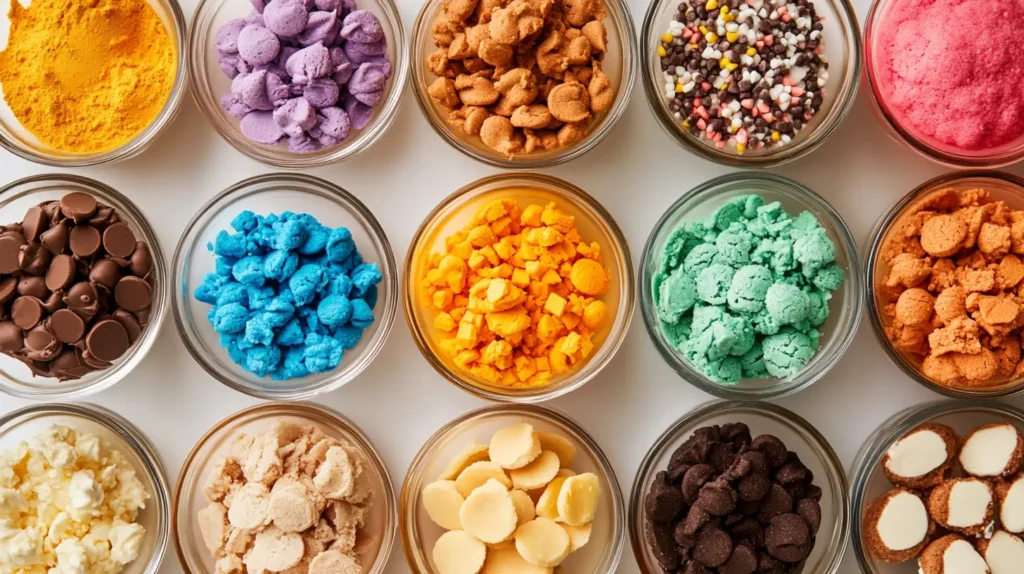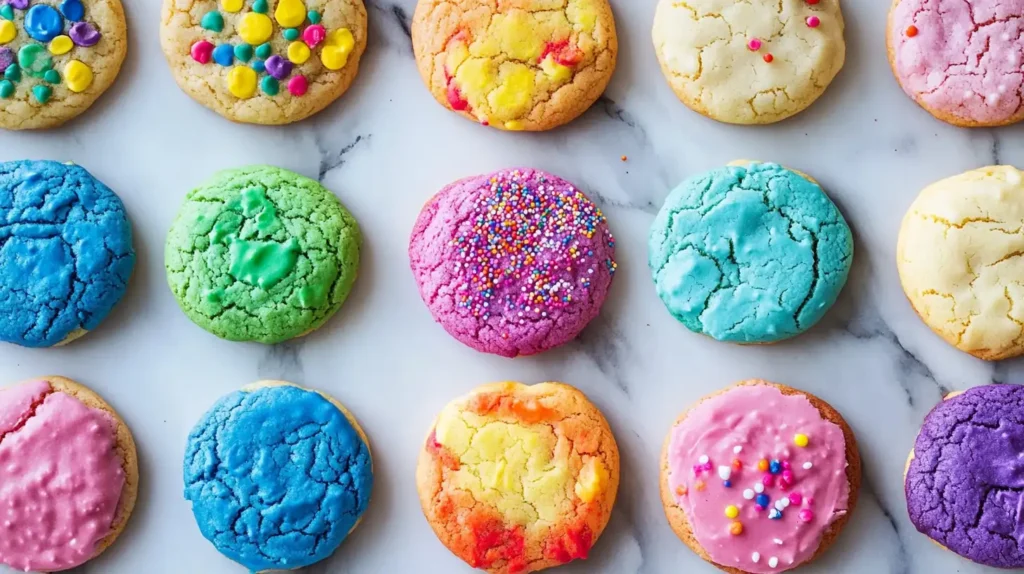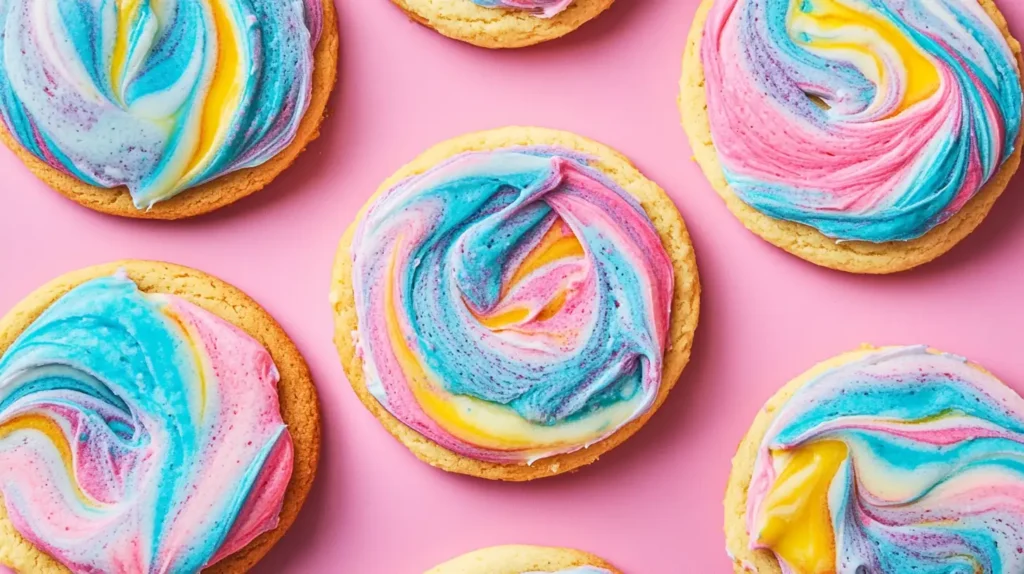Adding colorful ingredients to cookie recipes transforms them into edible works of art, perfect for any occasion. Whether you prefer natural or artificial hues, incorporating vibrant elements into your baking is both exciting and rewarding. Let’s explore how to create colorful cookies that taste as amazing as they look.

History and Origin of Colorful Ingredients Cookie Recipes
Colorful ingredients in cookie recipes have a fascinating history that intertwines culinary innovation with cultural traditions. While vibrant treats are ubiquitous today, their origin can be traced to various points in history where the use of colors served both aesthetic and symbolic purposes.
Early Use of Natural Colorings
Before the advent of artificial food coloring, bakers relied on natural sources to enhance the visual appeal of baked goods:
- Ancient Civilizations: Ancient Egyptians and Romans used ingredients like saffron and turmeric to dye their foods. Though primarily used for savory dishes, these ingredients occasionally appeared in sweet baked goods.
- Medieval Europe: During the Middle Ages, dried fruits like raisins, cherries, and apricots were incorporated into pastries, not only for their sweetness but also for their rich natural hues.
- Asian Influences: In East Asia, matcha (powdered green tea) was used to add vibrant green tones to desserts, a practice that eventually spread to Western baking.
The Birth of Modern Colorful Cookies
The practice of adding vivid colors to cookies as we know it today gained momentum in the 19th and early 20th centuries:
- Sugar Cookies and Royal Icing: In Victorian England, cookies like sugar biscuits became canvases for colorful royal icing. These decorative treats were often associated with holidays and celebrations.
- Festive Traditions in Europe: In countries like Germany and Italy, colorful sprinkles and candied fruits were incorporated into Christmas cookies. For example, Italian rainbow cookies feature layers of brightly colored almond sponge cake.
- American Influence: By the mid-20th century, American bakers embraced the growing availability of artificial food dyes, using them in cookies like “funfetti” or brightly frosted sugar cookies.
Introduction of Artificial Food Dyes
The invention of synthetic food coloring in the 19th century revolutionized baking. These dyes, derived from coal tar and later from petroleum, allowed for a broader spectrum of vivid colors:
- 1906 Pure Food and Drug Act: Regulations ensured food dyes were safe for consumption, increasing their popularity.
- Mass Production of Sprinkles and Candies: In the 1950s, the widespread availability of sprinkles, M&Ms, and other colorful toppings made vibrant cookies more accessible to home bakers.
Cultural Significance of Colorful Cookies recipes
- Holiday Celebrations: Vibrant reds, greens, and whites dominate Christmas cookie recipes, while pastels are preferred for Easter treats. Halloween cookies often showcase orange and black themes.
- Symbolic Meanings: Colors in cookies have been used to reflect cultural meanings—red for good luck in Chinese traditions or green for springtime renewal in Western Easter celebrations.
- Festive Personalization: Customizable colorful cookies have become staples at weddings, birthdays, and themed events.
Modern-Day Trends
The use of colorful ingredients has expanded with the rise of natural food dyes and edible decorations:
- Health-Conscious Baking: Modern bakers often substitute artificial dyes with natural ingredients like beet juice, butterfly pea flower, or spirulina.
- Artistic Cookie Creations: Advances in edible decorations, such as metallic dusts and intricate sprinkles, have elevated cookies into edible art pieces.
- Global Influences: Ingredients like matcha, dragon fruit powder, and turmeric have brought vibrant colors and flavors from different cultures into mainstream baking.
The history of colorful ingredients in some cookies reflects a blend of tradition, creativity, and innovation. From the natural dyes of ancient times to the bold artificial hues of modern baking, these vibrant treats continue to delight and inspire bakers and cookie lovers around the world.
The Psychology of Color in Food
Colors play a critical role in how we perceive taste and enjoyment. Bright, cheerful hues like reds, yellows, and greens evoke feelings of happiness, making colorful cookies a favorite choice for celebrations. Vibrant colors also create an emotional connection, turning ordinary cookies into memorable treats.
Types of Colorful Ingredients in Cookie for Baking

Natural Colorful Ingredients
For health-conscious bakers, naturally colorful ingredients provide an excellent option:
- Fruits: Dried berries, citrus zest, and purees add color and flavor.
- Spices: Matcha, turmeric, and saffron bring vibrant green and golden hues.
- Vegetables: Beetroot, spinach, and pumpkin are fantastic for dough coloring.
These ingredients not only enhance the visual appeal but also add nutritional value. For another example of using natural ingredients, check out this Pumpkin Banana Loaf recipe.
Artificial Colorful Ingredients
For bolder, more vibrant effects, artificial options such as food dyes, sprinkles, and candy-coated chocolates are ideal. They’re especially effective in festive cookies for holidays like Christmas and Easter.
Creative Recipe Ideas Featuring Colorful ingredients cookie recipes
Rainbow Cookies
- Use layers of dough in different colors to create a marbled or rainbow effect.
- Combine both natural and artificial food coloring for intricate patterns.
Funfetti Cookies
- Add rainbow sprinkles directly into the dough for a playful touch.
- Perfect for children’s parties and festive events.

For those interested in trying unique and unconventional recipes, explore the possibilities with this crumbl cookie recipe, which inspires creativity in flavor and presentation.
Techniques for Baking Colorful ingredients cookie recipes
Creating stunning colorful cookies requires some key techniques:
- Prevent Color Fading: Use gel-based colors and chill the dough before baking.
- Layer and Swirl: Combine colored doughs carefully for marbled effects.
- Decorating After Baking: Apply vibrant icing and toppings to maintain brightness.
DIY Natural Food Dyes
Adding vibrant hues to your cookie recipes can make them stand out, and using natural food dyes ensures your creations are as wholesome as they are beautiful. Here’s how to make your own DIY natural food dyes using colorful ingredients:
1. Fruits for Bright Reds and Pinks
- Beetroot Powder or Juice: This colorful ingredient delivers a stunning red or pink to cookie recipes. Simply mix beet powder or juice into your dough or icing for vibrant results.
- Raspberries and Strawberries: Puree these berries and strain to use the liquid. They add a soft pink to your cookie recipes without overpowering the flavor.
2. Vegetables for Greens and Yellows
- Spinach or Matcha Powder: Add these natural dyes to create a cheerful green shade in your cookie recipes. Spinach is mild in flavor, while matcha brings a slight earthy note.
- Turmeric Powder: A pinch of turmeric adds a sunny yellow hue. It’s an excellent colorful ingredient for lemon or ginger cookie recipes.
3. Spices and Teas for Browns and Oranges
- Cocoa Powder: Perfect for cookie recipes needing a chocolatey touch, cocoa delivers a deep brown naturally.
- Paprika or Carrot Juice: Both add a warm orange tone, ideal for autumn-themed cookie recipes.
- Chai Tea or Coffee: Brew and concentrate these flavorful colorful ingredients to achieve rich browns.
4. Berries for Purples and Blues
- Blueberries and Blackberries: Puree and strain these berries to add deep purples to cookie recipes. For blue tones, adjust blueberry juice with baking soda.
- Red Cabbage: Boil red cabbage and use its juice. Adjust its pH with lemon juice (purple) or baking soda (blue) for a creative twist.
Tips for Using Natural Food Dyes
- Add dyes gradually to control the intensity of your colorful ingredients in cookie recipes.
- Mix dyes with wet ingredients first to ensure even distribution.
- Remember that natural dyes may influence the taste—test small batches before scaling up.
Troubleshooting Common Issues
While natural food dyes enhance cookie recipes, they can also present challenges. Here’s how to troubleshoot common problems when using colorful ingredients:
1. Colors Are Too Faint
- Solution: Increase the concentration of your dye or layer it in frostings or glazes for stronger colors.
- Tip: Some colorful ingredients, like beet juice, become more vibrant after baking.
2. Uneven Coloring
- Solution: Mix natural dyes with wet ingredients before adding them to dry mixes in your cookie recipes. For icings, stir thoroughly to ensure consistency.
3. Colors Fade During Baking
- Solution: Natural dyes may lose vibrancy with heat. Try baking at a lower temperature or use colorful ingredients in no-bake recipes like glazes.
4. Flavors Interfere with the Cookie
- Solution: Balance strong-flavored dyes like turmeric or matcha by using extracts like vanilla or almond. Reduce the quantity if the taste is too strong.
5. Dough Becomes Too Sticky
- Solution: Liquid dyes can alter dough consistency. Use powdered versions of colorful ingredients or add a bit more flour to your cookie recipes.
6. Unexpected Color Changes
- Solution: Some natural dyes, like red cabbage, are sensitive to pH changes, leading to surprising results. Test your cookie recipes on a small scale to predict color behavior.
FAQs About colorful ingredients in cookie recipes
How to Add Food Coloring to Cookies?
Adding food coloring to cookie recipes is simple and can be done in a variety of ways depending on the type of cookie you’re making:
- For Cookie Dough:
- Use gel food coloring or powder food coloring for the most vibrant results.
- Add the coloring to the wet ingredients before mixing with dry ingredients to ensure even distribution.
- Start with a small amount and gradually increase until the desired color is achieved.
- For Icing or Decorations:
- Add liquid, gel, or powdered food coloring directly to the icing or glaze.
- Stir thoroughly for a consistent color, or lightly mix for a marbled effect.
- Tips:
- Avoid overmixing dough after adding color, as it can alter the texture.
- Use gloves to avoid staining your hands while working with food coloring.
What Are Rainbow Cookies Made From?
Rainbow cookies, often associated with Italian-American baking, are made from:
- Layers of Almond Sponge Cake: Colored in vibrant red, green, and uncolored layers.
- Raspberry or Apricot Jam: Spread between the layers to hold them together.
- Chocolate Coating: Melted dark chocolate is poured on top for a rich finish.
These cookies are known for their distinctive colorful layers and almond flavor.
How Do You Make Cookie Color?
To make cookies colorful:
- Incorporate Food Coloring:
- Mix gel or powdered food coloring into the dough or icing.
- Use Natural Ingredients:
- Add beet powder for pink, matcha for green, or turmeric for yellow.
- Decorate with Sprinkles or Edible Glitters:
- Press sprinkles onto the dough before baking or add them as a finishing touch after icing.
These methods can produce anything from subtle hues to bold and vibrant colors.
What Ingredient Makes a Cookie Dense?
The density of a cookie often depends on the ratio of its ingredients. Key contributors to dense cookies are:
- Butter or Shortening: A higher fat content creates a denser, chewier texture.
- Flour: Using more flour can lead to a thicker, denser cookie.
- Eggs: Using extra eggs (especially egg yolks) adds richness and moisture, making cookies denser.
- Low Leavening Agents: Using less baking powder or soda limits the rise, creating a denser result.
For a denser cookie, avoid overmixing, as this incorporates air, which can make the cookies fluffier.
The Joy of Baking with Colors
Adding colorful ingredients to cookies not only makes them visually stunning but also brings joy to every bite. Whether you use natural hues or embrace artificial options, the possibilities are endless. Start experimenting today and turn your kitchen into a canvas for creativity!

